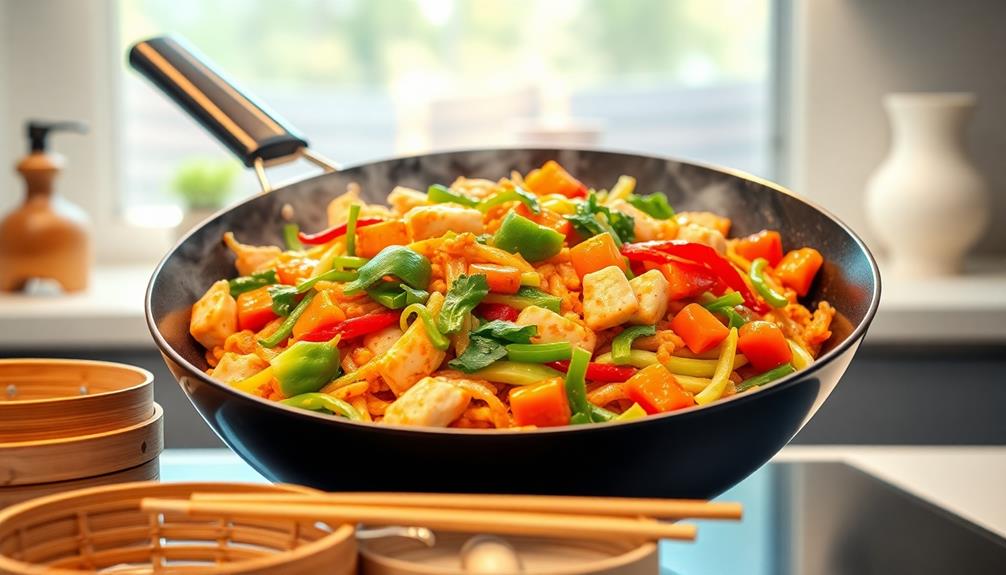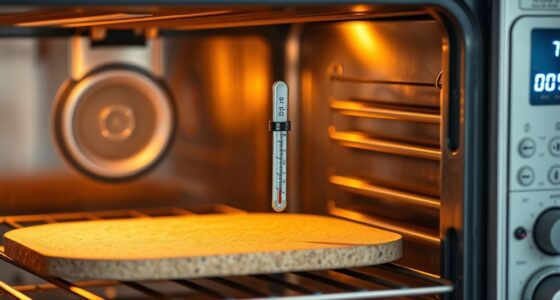Imagine stepping into your kitchen and feeling an immediate sense of calm—a space that inspires creativity rather than chaos. In today’s fast-paced world, the kitchen is not just a place to cook; it’s a hub of family life, a sanctuary for culinary exploration, and often, a battleground against clutter. By implementing kitchen efficiency tips, you can transform even the smallest of kitchens into an organized paradise that truly reflects your culinary dreams.
Maximizing kitchen space begins with understanding the essence of organization. As you peel back the layers of clutter—the unused gadgets gathering dust, the duplicates of items you rarely reach for—you’re not merely clearing space; you’re fostering an environment where your cooking passion can thrive. Healthy materials like metal and glass not only serve your culinary needs but also nurture your well-being. Embracing these kitchen organization ideas can help you build a space where creativity flourishes, and cooking becomes a joyful experience.
Key Takeaways
- Items unused for over a year should be considered for sale or donation to free up kitchen space.
- Remove items used less than once a month to optimize your kitchen environment.
- Prioritize kitchen tools made from healthy materials for environmental and health benefits.
- Minimize duplicates of rarely-used items to declutter.
- Evaluate the placement of non-cooking related items to maximize essential cooking tools’ accessibility.
Understanding Kitchen Efficiency
Kitchen efficiency encompasses various aspects crucial for enhancing your cooking experience. It involves the optimal use of space and resources, allowing for smoother meal preparation and effective access to essential tools. By understanding these principles, you can maximize your space, particularly in smaller kitchens where every inch counts.
What is Kitchen Efficiency?
At its core, kitchen efficiency refers to the streamlined workflow that enables you to prepare meals quickly and effectively. An efficient layout incorporates strategic zoning for different activities, minimizing cross-contamination and enhancing cooking speed. Implementing kitchen efficiency tips can help you choose the right equipment and tools that not only significantly reduce preparation time but also contribute to a more enjoyable cooking experience.
Importance of an Efficient Kitchen
The importance of an efficient kitchen cannot be overstated. Designed with functionality in mind, such kitchens help in controlling food costs by reducing waste and support energy-efficient practices that lower operational expenses. A well-organized kitchen leads to happier cooking moments, reduces stress, and fosters innovation. Embracing these principles not only improves daily operations but also enhances customer satisfaction in both home and restaurant kitchens. Investing in a culture of continuous improvement can lead to various kitchen workflow optimizations.

| Kitchen Feature | Benefits |
|---|---|
| Efficient Layout | Reduces cooking time and minimizes mess |
| Proper Equipment | Ensures consistency in cooking and speeds up processes |
| Inventory Management | Helps track stock and reduces unnecessary waste |
| Trained Staff | Enhances service quality and kitchen efficiency |
| Energy-Efficient Appliances | Reduces operational costs while maintaining performance |
Declutter Your Kitchen for Better Space
Decluttering your kitchen is a vital step toward enhancing both space and functionality. Begin by thoroughly assessing your current kitchen items to identify what is essential and what merely occupies valuable spaces. This process is not just about aesthetics; it significantly contributes to practical kitchen efficiency strategies. A well-organized kitchen can help streamline your cooking process, making meal preparation enjoyable and efficient.
Assess Your Current Kitchen Items
While taking inventory of your kitchen, ask yourself a series of questions to guide your decluttering efforts:
- When was the last time I used this?
- Does this item make my life significantly easier in the kitchen?
- How many of these do I really need or use at one time?
- Am I holding onto this “just in case” or for sentimental reasons?
- Is this something I could borrow if needed?
- Would I buy this again today?
The goal here is to keep only what you use regularly, which is essential for maintaining kitchen organization ideas.
Keep Only What You Use Regularly
This decluttering process leads to multiple benefits. A decluttered kitchen is easier to clean and maintain, reducing the risk of cross-contamination and enabling more efficient meal planning. Not to mention, it can enhance your cooking experience by reducing stress and promoting creativity in the kitchen. Lower food waste occurs when you keep track of what you have, which can also lead to financial savings.
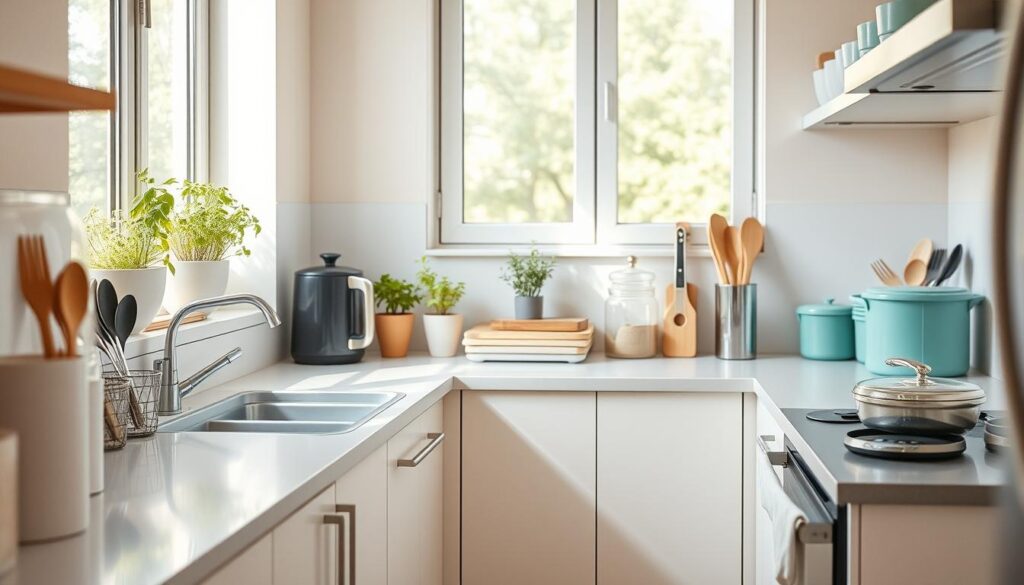
Employ tips to declutter your various kitchen areas effectively. For countertops, remove unnecessary items and sort through papers into categories of keep, shred, or recycle. Store small appliances not used daily. For cabinets and drawers, tackle easy categories first, avoiding overwhelming yourself with too many areas at once. Implementing these practical kitchen efficiency strategies can truly transform your cooking environment.
| Declutter Area | Action Items |
|---|---|
| Countertops | Remove unnecessary items and reduce decor |
| Cabinets | Sort containers and remove duplicates |
| Drawers | Utilize organizers for utensils and tools |
| Pantry | Check for expired items and duplicates |
| Refrigerator | Dispose of expired ingredients and organize shelves |
| Freezer | Label items and remove old food |
Smart Storage Solutions for Small Kitchens
In small kitchens, finding effective ways to maximize kitchen space without compromising style is crucial. Smart storage solutions not only help to keep your kitchen organized but can also add a decorative flair. By utilizing vertical space wisely and implementing open shelving ideas, you can transform your kitchen into a functional and attractive area.
Use Vertical Space Wisely
One of the best strategies to maximize kitchen space involves taking advantage of vertical surfaces. Install shelves above cabinets and use wall-mounted racks to store cookware, utensils, and other kitchen essentials. Magnetic strips can free up drawer space, allowing for easy access to knives and small tools. Command hooks serve as a great option for hanging lightweight items on the inside of cabinet doors, helping to keep your counters clear and organized.
Implement Open Shelving Ideas
Open shelving can change the dynamic of your kitchen dramatically. Not only does it provide a convenient place for frequently used items, but it showcases your collection of dishes and pantry items beautifully. Statistics show that 72% of kitchen designers recommend open shelving to enhance both décor and functionality. Utilize shelf risers to create additional height for stacking, while pegboards serve as versatile storage for pots and pans. This approach enhances efficiency by grouping similar items together, making them more accessible and easier to manage.

| Storage Solution | Description | Benefits |
|---|---|---|
| Vertical Shelving | Spaces above cabinets and walls | Maximizes unused space and keeps items accessible |
| Open Shelving | Exposed shelves for displaying and storing | Adds aesthetic appeal and functionality |
| Magnetic Strips | Wall-mounted strips for knives and tools | Clears drawer clutter and provides easy access |
| Command Hooks | Hooks for hanging items inside doors | Organizes small items efficiently |
| Pegboards | Wall-mounted boards for pots and utensils | Offers flexible storage solutions |
Kitchens Organization Ideas
Efficient kitchens organization ideas transform your cooking space into a well-ordered environment. Implementing these strategies can streamline your kitchen tasks, making cooking and entertaining a joy rather than a chore. Utilizing containers and labels for pantry items, maximizing vertical storage with adjustable shelving, and using drawer organizers for utensils and tools are all examples of efficient kitchen organization. These ideas not only save time and energy, but also create a more visually appealing and calming environment in your kitchen. With efficient kitchen organization, you can take the stress out of meal preparation and focus on enjoying the process of creating delicious and nutritious meals for yourself and your loved ones.
Utilize Drawer Inserts for Utensils
One effective way to maintain a tidy kitchen is to use drawer inserts for your utensils. These handy tools keep items like spatulas and spoons in designated spots. Such organization prevents chaos whenever you open a drawer. With a variety of sizes and materials available, you can customize drawer inserts to fit your specific needs. Consider using compartmentalized trays to easily separate knives, forks, and spoons, making meal preparation more efficient.
Install Pull-Out Shelves for Easy Access
Incorporating pull-out shelves into deep cabinets greatly enhances accessibility. No more struggling to reach items tucked away in the back. Pull-out shelves bring pots, pans, and other kitchen essentials right to your fingertips. This design not only maximizes storage but also promotes better organization by allowing you to see everything at a glance. It’s a smart solution for those who wish to create a seamless cooking experience.
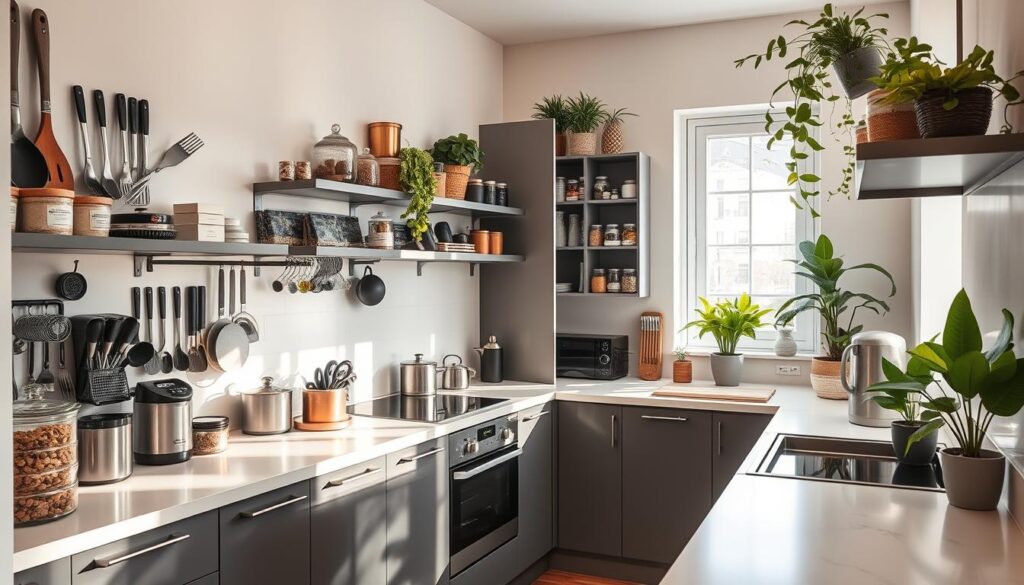
Kitchen Efficiency Tips for Streamlining Meal Prep
Meal preparation can often feel overwhelming, but incorporating efficient cooking tips can make a significant difference. Effectively planning your meals ahead of time not only saves you stress but also fosters a smoother cooking experience. By knowing what you plan to create, grocery shopping becomes less chaotic, allowing for a more enjoyable time in the kitchen.
Planning Your Meals Ahead of Time
Setting a meal plan can save an impressive 80% of the time spent cooking through efficient kitchen organization. Designate a weekly time to outline your meals and make a shopping list to ensure you have the necessary ingredients at hand. By focusing on streamlined menus, you can encourage the shared use of ingredients among dishes, significantly reducing food waste while maximizing kitchen efficiency.
Organizing Ingredients for Quick Access
Arranging your kitchen in a way that allows for quick access to ingredients is key to efficient meal prep. Consider these strategies to boost productivity:
- Place frequently used items at eye level for easy access, which can enhance kitchen efficiency by 40%.
- Utilize large cutting boards and prep bowls to consolidate your ingredients, saving up to 35% of the time spent transitioning between items.
- Store cooking oils in a cool, dark place near the stove for easy access and a potential 20% time savings during cooking.
- Keep commonly used seasonings organized and near the stove to further reduce search time by 15%.
This organizational approach allows you to avoid unnecessary delays, optimizing the overall cooking process. Consider creating dedicated zones in your kitchen for prepping, cooking, and storage. Establishing these work areas can reduce prep time by as much as 50%, ensuring you enjoy a simplified cooking experience.
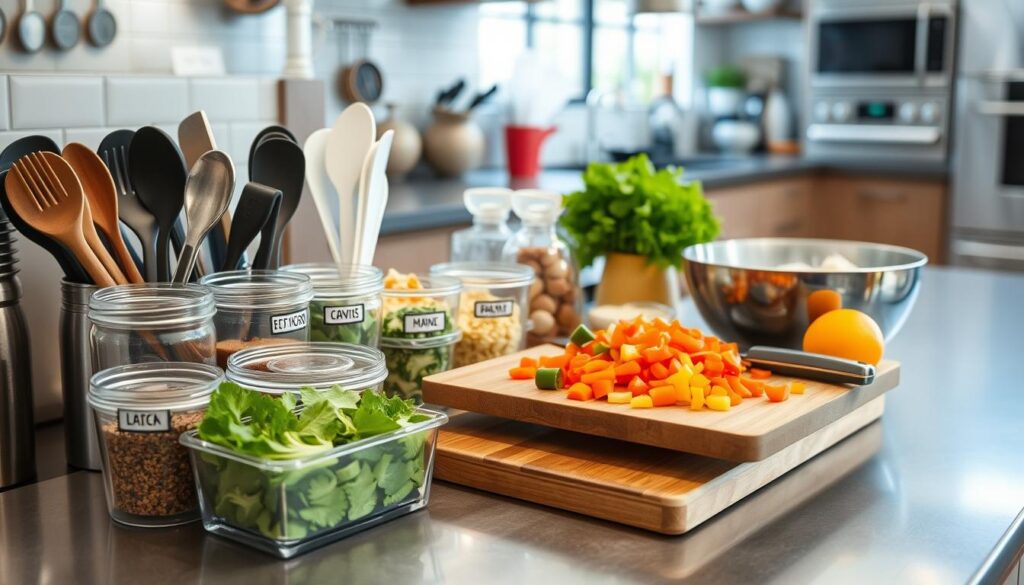
| Strategy | Time Savings |
|---|---|
| Organize frequently used items | 40% |
| Utilize large prep tools | 35% |
| Store oils near cooking area | 20% |
| Keep seasonings accessible | 15% |
| Implement dedicated prep zones | 50% |
Incorporate these kitchen efficiency tips, and watch as your meal prep efforts become more streamlined and enjoyable. Efficient cooking is just a few organized steps away!
Optimize Kitchen Workflow
Creating a seamless process in the kitchen requires a focus on efficient layouts and well-organized work areas. One key approach is to apply the kitchen triangle design principle, which emphasizes the relationship between the sink, stove, and refrigerator. Understanding how these essential areas interact can significantly enhance your ability to optimize kitchen workflow.
The Kitchen Triangle Design Principle
The kitchen triangle design principle posits that the three primary work zones should form a triangle to facilitate movement and efficiency. By keeping these zones within a short distance of one another, you can streamline your cooking process and save valuable time. This thoughtful arrangement minimizes unnecessary steps, allowing you to tackle meal preparation with ease. Consider measuring the distances to ensure each leg of the triangle is balanced, typically ranging between 4 to 9 feet, ensuring comfort as you navigate between tasks.
Efficient Cooking Stations
Establishing efficient cooking stations within your kitchen supports an organized and productive environment. You can enhance workflow by creating designated areas for specific tasks, such as food prep, cooking, and plating. Each station should be stocked with the necessary tools and ingredients for its purpose. This arrangement not only minimizes clutter but also allows for quick access to items, essential for a rapid cooking pace. Consider these elements while designing your cooking stations:
- Assign distinct roles for each station (e.g., prep, cooking, cleaning).
- Ensure all tools and ingredients are within reach of each station.
- Implement smart storage solutions to keep items orderly.
- Incorporate energy-efficient equipment to reduce costs and environmental impact.
Ultimately, focusing on the kitchen triangle design principle alongside the establishment of efficient cooking stations enables a smooth workflow. By prioritizing organization and strategic layout, you make cooking a more enjoyable experience.

Making Use of Cabinet and Countertop Space
In a kitchen, every inch counts, particularly when it comes to cabinet and countertop space. Applying efficient storage techniques ensures your kitchen remains organized and functional. Here are two effective strategies to enhance storage and improve overall kitchen efficiency.
Maximize Upper Cabinet Storage
To maximize upper cabinet storage, consider adjusting the heights of shelves to accommodate larger items or canisters. Investing in stackable bins for fruits and vegetables can significantly free up essential countertop space. Implementing these practical kitchen efficiency strategies increases the utilization of vertical space, allowing your cabinets to better serve your needs. Using clear containers can also make finding ingredients easier while keeping a clean aesthetic.
Use Undershelf Baskets for Extra Space
Another innovative way to make the most of your cabinet space is by installing undershelf baskets. These clever additions can hold snacks, spices, or kitchen tools that often clutter counters. By incorporating hidden storage solutions and drop-down storage trays, you create more organized environments while maintaining a clean look on your countertops. These methods encourage you to maximize upper cabinet storage, ensuring that your cabinet and countertop space is used to its fullest potential.
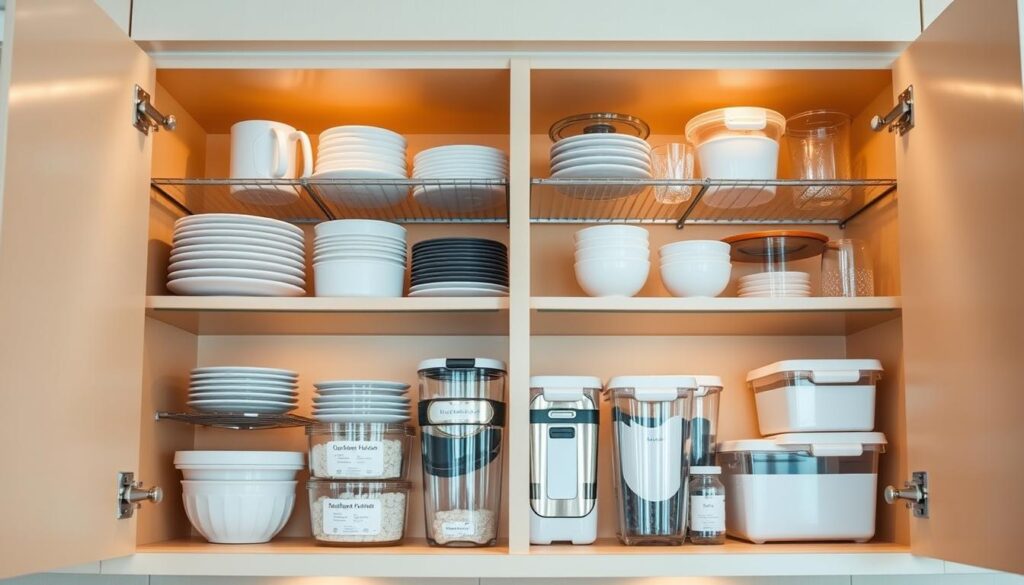
Practical Kitchen Efficiency Strategies
In modern kitchens, organization plays a vital role in enhancing functionality. By implementing practical kitchen efficiency strategies, you can significantly streamline your cooking and preparation processes. Simple adjustments, such as utilizing lazy susans and drawer and cabinet dividers, can transform your kitchen from chaotic to organized.
Utilizing Lazy Susans for Spices
Lazy susans are excellent tools for keeping spices organized and easily accessible. They allow you to make use of corner spaces in cupboards or on countertops, ensuring that every spice is within reach when you need it. With a simple spin, you can quickly find the spice you’re looking for, saving time during meal prep. It’s a practical kitchen efficiency strategy that maximizes both storage and accessibility.
Drawer and Cabinet Dividers
Drawer and cabinet dividers help segment items, enhancing visibility and access to your kitchen essentials. By installing these dividers, you create designated spaces for utensils, tools, and other kitchen items, which minimizes clutter and frustration. This simple method significantly encourages organization, making your cooking experience both enjoyable and efficient.

| Strategies | Benefits |
|---|---|
| Utilizing Lazy Susans | Maximizes corner storage and increases accessibility |
| Drawer Dividers | Enhances organization and reduces clutter |
| Cabinet Dividers | Improves visibility and quick access to kitchen items |
Innovative Time-Saving Kitchen Hacks
Adopting smart techniques in your kitchen can remarkably enhance your cooking experience. Time-saving kitchen hacks not only streamline meal preparation but also maximize your space efficiency. Two standout methods that provide substantial benefits are pre-cutting vegetables and using a pot rack, altering how you interact with your kitchen.
The Benefits of Pre-Cutting Vegetables
Pre-cutting vegetables significantly reduces the time spent on meal prep. This practice allows you to grab the ingredients right when you need them, which is especially beneficial during busy weeknights. By organizing chopped vegetables in containers, you make cooking quicker and simplify your workflow. This approach is a true testament to effective time-saving kitchen hacks, enhancing both efficiency and enjoyment while cooking.
Using a Pot Rack to Save Space
Implementing a pot rack in your kitchen can drastically free up cupboard space. By hanging your pots directly above your prep area, you not only keep them easily accessible, but also create a visually appealing space. This effectively maximizes your kitchen’s functionality while maintaining a clutter-free environment. Such practical use of vertical space stands as one of the most effective time-saving kitchen hacks available today.

Conclusion
By incorporating kitchen efficiency tips into your culinary routine, you can significantly transform your cooking environment. Implementing strategies to maximize space and utilize innovative kitchen organization ideas not only streamlines meal prep but also enhances your overall cooking experience. Whether you’re working in a compact kitchen or a spacious culinary haven, these tactics make a world of difference.
Your journey towards an organized kitchen doesn’t have to be overwhelming. Simple tools such as a detailed kitchen prep list can help you track tasks, manage ingredients, and avoid the chaos of last-minute rushes. By categorizing tasks, prioritizing based on complexity, and allowing for multitasking, you will find that cooking becomes more enjoyable.
Moreover, utilizing vertical storage, such as pantry-style cabinetry or ceiling-high cabinets, can maximize space efficiency while providing ample room for your kitchen essentials. With thoughtful planning and reflection on time allocation, you’re set to create a kitchen that meets your needs and elevates your culinary adventures.




